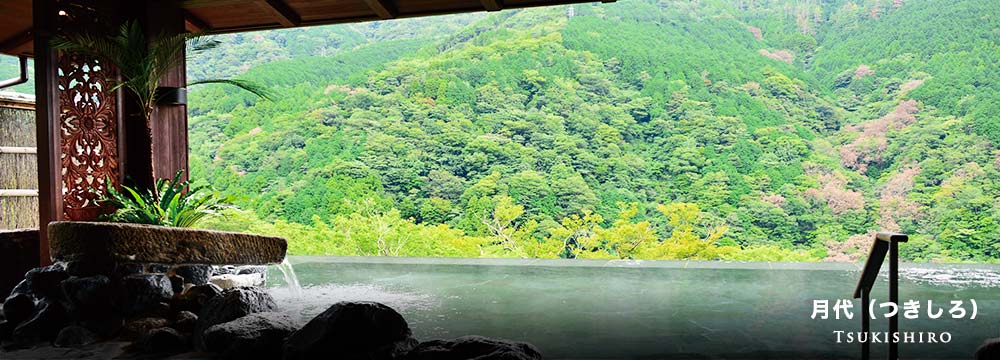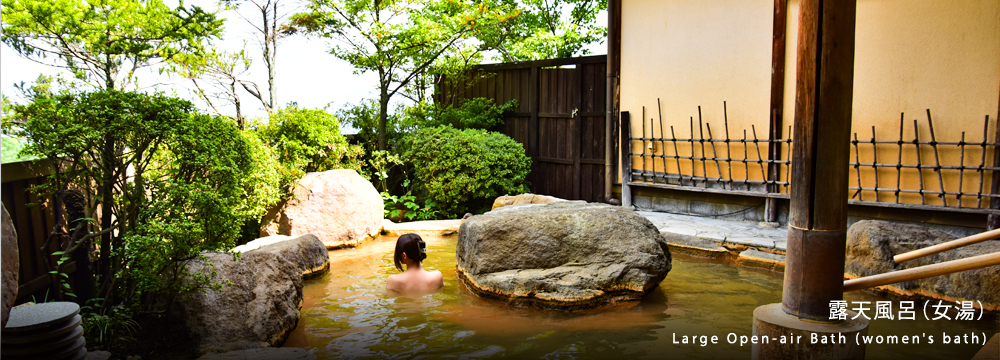
CHIGIRA JINSENTEI
| Calcium, Sodium – Sulfate / Hydrogen carbonate / Chloride springs | pH |
|
| カルシウム・ナトリウム-硫酸塩・炭酸水素塩・塩化物泉 | ||
| (Hypotonic, Neutral, Hot spring) | ||
| Old springs name:Bicarbonate earth springs―Gypsum spring | ||
Ideal for people like this
- Who want to test the skin beautifying effect
- Who have dry skin
- Who want to treat cuts quickly
- Who are feeling stressed
- Who have sensitivity to cold
- Who want to feel refreshed after bathing
- Address
- 45 Ikaho, Ikaho-machi, Shibukawa-shi, Gunma 377-0102, JAPAN
- Phone
- +81-(0)279-72-3355

Official Website

Travel Journal
Hot Spring Power Chart (5-point scale)
Hydrogen Ion Concentration (pH)

- Comment
- Neutral is a gentle hot spring with low-irritation
Hot spring Specification
※This is an easy-to-understand expression based on the indications for each type of spring in the "Standard Methods of Analysis for Mineral Springs" revised in July 2014 by the Ministry of the Environment.
| ①Mental recovery | ②Insomnia | ③Promote blood circulation | ④Sensitivity to cold | ⑤Dry skin |
| ⑥Cuts | ⑦Skin diseases | ⑧Hypertension (mild) | ⑨Heartburn (drinking) | ⑩Gastrointestinal disorders (drinking) |
| ⑪Constipation (drinking) | ⑫Lifestyle-related disease | ⑬Diabetes | ⑭Gout | ⑮Countermeasures against metabolic syndrome |
| ⑯Biliary system anxiety | ⑰Anaemia | ⑱Arthritis rheumatica | ⑲Spinal pain | ⑳Improved immunity |
| ㉑Muscle pain・Neuralgia | ㉒Mild asthma | ㉓Hemorrhoidal pain | ㉔Recovery from an illness | ㉕Recovery from fatigue |
- ※Note①・・・Indications for each spring include autonomic instability and depression.(Simple springs・Chloride springs・Sulfate springs・Carbon dioxide springs)
- ※Note③・・・Indications for each spring include peripheral circulatory disturbance(Chloride springs・Carbonate springs・Carbon dioxide springs・Hydrogen sulfide type Sulfur spring)
- ※Note④・・・Indications for each spring include sensitivity to cold(Chloride springs・Carbonate springs・Sulfur springs・Carbon dioxide springs)and Iron containing springs
- ※Note⑦・・・Indications for each spring include xeroderma, atopic dermatitis, plaque psoriasis, epidermoid suppuration, chronic eczema(Chloride springs・Carbonate springs・Sulfate spring・Acid springs・Sulfur springs)
- ※Note⑨・・・Indications for drinking each spring include reflux esophagitis(Carbonate springs)
- ※Note⑩・・・Indications for drinking each spring include atrophic gastritis, gastroduodenal ulcerations(Chloride springs・Carbonate springs)
- ※Note⑪・・・For drinking, Chloride springs and Sulfate spring
- ※Note⑫・・・Indications for each spring include hypercholesterolemia, diabetes, gout(for bathing, Acid springs・Radioactive springs/for drinking, Carbonate springs・Iodine containing springs・Sulfur springs)
- ※Note⑮・・・Indications for drinking each spring include hypercholesterolemia(Sulfate spring・Iodine containing springs・Sulfur springs)
- ※Note⑱⑲・・・Indications for each spring include rheumatoid arthritis, ankylosing spondylitis(Radioactive springs)
- ※Note⑳・・・Radioactive springs
- ※Note㉑㉔・・Simple springs is suitable for rehabilitation due to its low level of stimulation, and is also called "hot spring for neuralgia" and "hot spring for stroke", although these are not listed as indications by spring quality.
| Applicable to indications by spring quality | Applicable to general indications |
7 Elements of Hot Springs for Beautiful Skin
Total5Points ※The number of points represents the quality of the "Hot spring for beauty".
| Skin cleansing effect | Skin reviving effect | Skin whitening effect |
|---|---|---|
| Carbonate Springs | Sulfate Springs | Sulfur Springs |
| Skin smoothing effect | Skin Coating and moisturizing effect | Skin moisturizing effect | Cleaning effect |
|---|---|---|---|
| (Weak) Alkaline Springs | Chloride Springs | Metasilicic acid(100mg/kg or more) | Metaboric acid(10mg/kg or more) |
- ※The "Four Best Beauty Springs" are said to be "Carbonate spring", "Sulfate spring", "Sulfur spring", and "(Weak) Alkaline simple hot spring".
- ※The "Chloride spring" coats the skin with a salt pack, keeping it warm and moisturized at the same time. It is also called "Hot spring for finishing touch" to be taken after the "Hot spring for beauty" in which exfoliation has been removed.
- ※Hot springs containing 100 mg/kg or more of metasilicic acid have an excellent moisturizing effect and is said to be "Hot spring for beauty".
- ※Hot springs containing 10 mg/kg or more of metaboric acid have a cleansing effect, is used in some eye drops, and is said to be effective in treating acne.
Water texture while bathing(5-point evaluation)
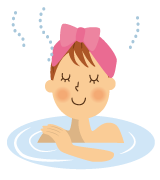
| Smoothly | Mushy | ||||||||||
|---|---|---|---|---|---|---|---|---|---|---|---|
| Powdery | Chewy | ||||||||||
| Fizzy | Tingling | ||||||||||
Skin feeling after bathing(5-point evaluation)
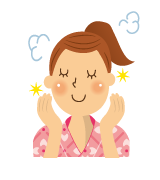
| Silky | Dryness | ||||||||||
|---|---|---|---|---|---|---|---|---|---|---|---|
| Powdery | Sticky | ||||||||||
| Moistly | Warmly | ||||||||||
View from the open-air bath (5-point evaluation)
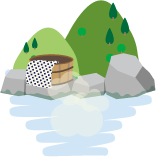
| Views of Mt.Onokoyama, Mt.Komochiyama, etc. |
| Public open-air baths for men and women |
| Point 4 |
|---|
Hot Spring Source Usage
| Water added No |
Heated No |
Disin fected No |
Circulated No |
Bath additive No |
|---|---|---|---|---|
| ○ | △ | ○ | ○ | ○ |
| ※All bathtubs heated only in winter | ||||
| Percentage of hot spring source |
100% | ||||
|---|---|---|---|---|---|
| Replacement frequency of hot spring water | Everyday | ||||
| Yield of hot spring water |
Centralized management by the "Komaguchi Right Holders Association" | ||||
| Distance from the source to the bathtub |
Approx. 800 m | ||||
| How hot spring water is drawn | Hot water is delivered from the source well to each inn through a chestnut wooden gutter using a drop-off | ||||
| How water temperature is adjusted | Adjust the volume of hot water poured into the bathtub | ||||
| Drinking Spring | Not drinkable ※Non-submission of application for drinking to the health department | ||||
| "Gensen-Kakenagashi" Bath | Public bath for men and women x 2, Open-air Bath x 2, Guest room Open-air Bath x 2, Private bath x 4 | ||||
Hot Spring Composition TableHot Spring Analysis Report
| Spring Quality | Calcium, Sodium – Sulfate / Hydrogen carbonate / Chloride springs(Hypotonic, Neutral, Hot spring) Old springs name:Bicarbonate earth springs―Gypsum spring |
|---|---|
| Color of hot spring | Dark reddish-brown |
| Scent of hot spring | Scent of iron |
| Dissolved substances | 1,184mg/kg(Sum of components (1) + (2) + (3), excluding gaseous substances) |
| Temperature of spring | 41.2℃ |
| pH | 6.4 (Neutral) |
| Yield | 4,627 liters per minute(Amount of "Kogane-no-Yu (Golden water)" for the entire Ikaho area) Usage of this inn: About 400 liters per minute Amount of hot spring use per person (yield / bath capacity):About 2.6 liters/person(maximum capacity of 150 people) |
Hot Spring Composition (Amount contained in 1 kg of spring)
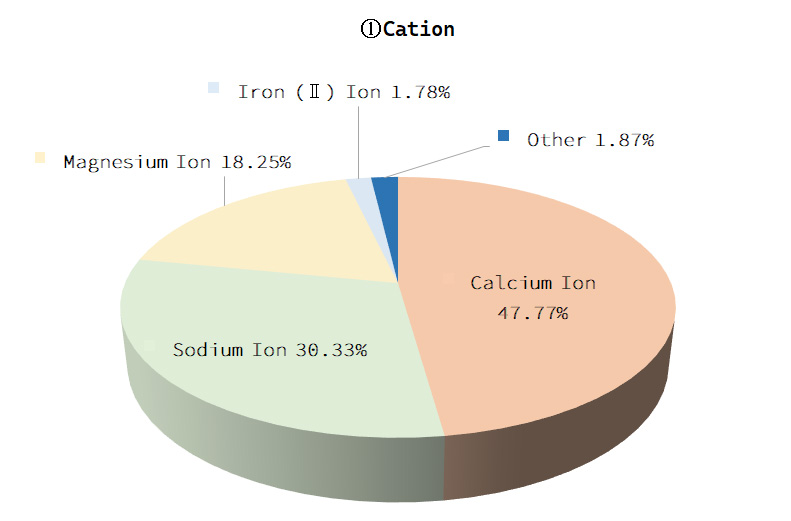 |
|||
|---|---|---|---|
| ①Cation | mg | mval | mval% |
| Calcium Ion (Ca2+)★ | 139.00 | 6.95 | 47.77 |
| Sodium Ion (Na+)★ | 101.00 | 4.41 | 30.33 |
| Magnesium Ion (Mg2+) | 32.20 | 2.65 | 18.25 |
| Iron(Ⅱ) Ion (Fe2+) | 7.23 | 0.26 | 1.78 |
| Potassium Ion (K+) | 8.70 | 0.22 | 1.53 |
| Manganese ion (Mn2+) | 1.39 | 0.05 | 0.34 |
| Aluminum ion (Al3+) | 0.050 | 0.00 | 0.00 |
| Cations Total(1) | 290.00 | 14.50 | 100.00 |
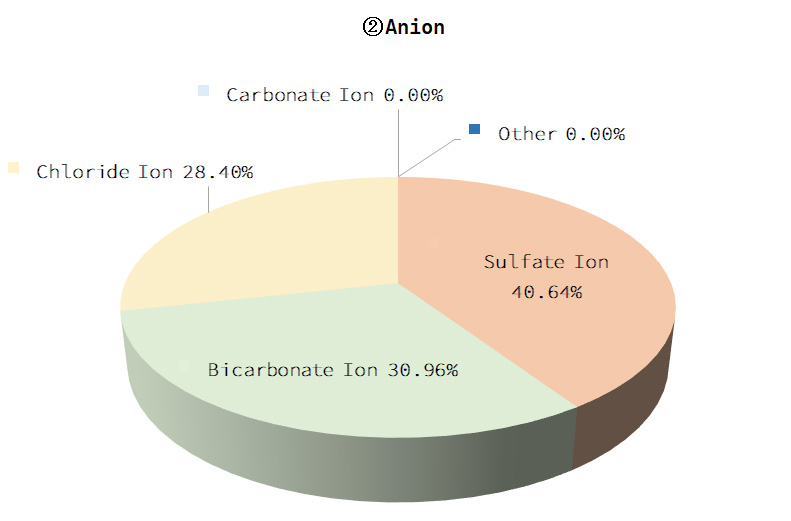 |
|||
|---|---|---|---|
| ②Anion | mg | mval | mval% |
| Sulfate Ion (SO42-)★ | 284.00 | 5.91 | 40.64 |
| Bicarbonate Ion (HCO3-)★ | 275.00 | 4.50 | 30.96 |
| Chloride Ion (Cl-)★ | 146.00 | 4.13 | 28.40 |
| Carbonate Ion (CO32-) | 0.10 | 0.00 | 0.00 |
| Fluoride Ion (F-) | 0.10 | 0.00 | 0.00 |
| Anion Total(2) | 705.00 | 14.50 | 100.00 |
| ③Undissociated Components | mg | mmol | |
|---|---|---|---|
| Metasilicic Acid (H2SiO3)★ | 181.00 | 2.31 | |
| Metaboric Acid (HBO2)★ | 8.30 | 0.19 | |
| Undissociated Components Total(3) | 189.00 | 2.50 | |
| Dissolved Gas Components | mg | mmol | |
|---|---|---|---|
| Free Carbon Dioxide (CO2) | 172.00 | 3.90 | |
| Free Hydrogen Sulfide (H2S) | 0.00 | 0.00 | |
| Dissolved Gas Components Total(4) | 172.00 | 3.90 | |
| Other Trace Components | |||
|---|---|---|---|
| Total arsenic 0.017 mg/ Total mercury, Lead ions, Copper ions not detected |
★are the ingredients related to the "spring quality" and the ingredients that qualify conditions for "hot spring" and "therapeutic hot spring".
Indications by Spring Quality for Bathing (Revised on July 1, 2014)
Cuts, Peripheral circulatory disturbance, Sensitivity to cold, Depression, Dry skin
General Indications for Bathing (Revised on July 1, 2014)
Chronic pain or stiffness of muscles or joints (chronic phase of rheumatoid arthritis, osteoarthritis, lower back pain, neuralgia, frozen shoulder, bruises, sprains, etc.),
muscle stiffness by motor paralysis, sensitivity to cold, peripheral circulatory disturbance,
gastrointestinal hypofunction (slow digestion, intestinal gas formation, etc.),
mild hypertension, impaired glucose tolerance (diabetes), mild hypercholesterolemia,
mild asthma or emphysema, pains of hemorrhoidals, autonomic instability,
various symptoms from stress (sleep disorders, depression, etc.),
restorative phase from illness, recovery from fatigue, health promotions
Contraindications by Spring Quality for Bathing (Revised on July 1, 2014)
None
General Contraindications for Bathing (Revised on July 1, 2014)
Active stage of diseases (especially when fever is accompanied), active tuberculosis,
advanced malignant tumor, or the case of significant debility involving severe anemia,
severe cardiac or lung diseases involving suffocation feelings with a little movement,
severe kidney disease involving edema, gastrointestinal bleeding,
when there is visible bleeding, acute exacerbation stage of chronic diseases, etc.
Indications by Spring Quality for Drinking
Not drinkable
Date of Analysis (The above hot spring composition table is cited from the survey data of the following institution)
May 30, 2017 (Gunma Pharmaceutical Association Environment and Health Testing Center)
- ※Indications and Contraindications for hot springs are in accordance with "Standard Methods of Analysis for Mineral Springs" revised on July 1, 2014.
- ※Data was provided by the ryokan.
20 qualifications for "hot spring" and 8 qualifications for "therapeutic hot spring"
| Conditions/Components (contained amount in 1kg) ※If even one of the conditions is cleared, it is a "hot spring" or "therapeutic hot spring" |
A【Hot Springs Act】 Conditions of the "hot spring" |
B【Standard Methods of Analysis for Mineral Springs】 Conditions of the "therapeutic hot spring" |
|
|---|---|---|---|
| 1 | Temperature (when collected from source) | 25℃ or more | |
| 2 | Dissolved substances (excluding gaseous) | Total amount 1,000mg or more | |
| 3 | Free carbon dioxide (CO2) | 250mg or more | 1000mg or more(Carbon dioxide springs) |
| 4 | Lithium Ion (Li+) | 1mg or more | ― |
| 5 | Strontium Ion (Sr2+) | 10mg or more | ― |
| 6 | Barium Ion (Ba2+) | 5mg or more | ― |
| 7 | Total Iron Ion[Fe2+(Iron(Ⅱ) Ferro ion)+Fe3+(Iron(Ⅲ) Ferri ion)] | 10mg or more | 20mg or more(Iron containing springs) |
| 8 | First Manganese Ion (Mn2+) | 10mg or more | ― |
| 9 | Hydrogen Ion (H+) | 1mg or more | 1mg or more (Acidic springs) |
| 10 | Bromine Ion (Br-) | 5mg or more | ― |
| 11 | Iodide Ion (I-) | 1mg or more | 10mg or more (Iodine containing Springs) |
| 12 | Fluoride Ion (F-) | 2mg or more | ― |
| 13 | Hydro Arsenate Ion (HAsO42-) | 1.3mg or more | ― |
| 14 | Meta Arsenite (HAsO2) | 1mg or more | ― |
| 15 | Total sulfur (S) [HS-(Hydrogen sulfide ion)+S2O32-(Thiosulfate Ion)+H2S(Free hydrogen sulfide)] | 1mg or more | 2mg or more (Sulfur Springs) |
| 16 | Metaboric acid (HBO2) | 5mg or more | ― |
| 17 | Metasilicic acid (H2SiO3) | 50mg or more | ― |
| 18 | Bicarbonate soda (NaHCO3) | 340mg or more | ― |
| 19 | Radon (Rn) | 20 or more (unit: ten ppb curie) 20×10-10or more Ci(curie) 20 or more (ten ppb curie) =74Bq(becquerel)/5.5 or more mache |
30 or more nanocurie(Radioactive springs) 30×10-10or more Ci(curie) 30 or more (ten ppb curie) =111Bq(becquerel)/8.25 or more mache |
| 20 | Radium salt (as Ra) | 10-8mg or more 1/100 million mg or more |
― |
| Number of conditions cleared this "hot spring" or "therapeutic hot spring" is: | 5 (Out of 20) | 2 (Out of 8) | |
| Total 7 Points | |||
Hot Spring Legends and More
Traditionally documented efficacies
-
Historical figures who bathed in this hot spring
-
Celebrities who bathed in this hot spring
Numerous cultural and celebrity visitors, not mentioned due to private uses
Hot Spring (Onsen) Report
Gunma Prefecture is home to three hot spring areas known as the "Three Famous Hot Springs of Jyoshu (Kusatsu Onsen, Ikaho Onsen, and Shima Onsen)", and one of them, Ikaho Onsen, is famous for a reddish-brown hot spring called "Kogane-no-Yu" (golden water). When it gushes out from the source, it is clear and colorless, but the iron contained in the water oxidizes when exposed to the air, giving it its mysterious color. "Onsen manju", an essential sweets in hot spring areas in Japan, is often brown in color, which is based on the color of this "Kogane-no-Yu" (golden water).
The name of the hot spring at "Kogane-no-Yu" is "Calcium, Sodium- Sulfate / Hydrogen carbonate / Chloride Springs". In simple words, it is a hot spring with the 3 characteristics of a Sulfate Springs, Hydrogen Carbonate Springs, and a Chloride Springs. The pH value is 6.4, neutral. Human skin is weakly acidic, and because the pH value is close to this, it is low-irritation and feels gentle on the skin.
First, the most notable dissolved substances in hot springs are the cation calcium ion and the anion sulfate ion, which are the most concentrated. These are combined to make a "Calcium-Sulfate Spring". In the old name of the spring, this spring was classified as a "Gypsum springs", and the sulfate ions are said to have the effect of closing cuts at the same time as stimulating the elasticity of the skin and preventing wrinkling. For this reason, it is also called "Hot springs for cuts" and "Hot springs for anti-aging". Calcium ions are also known as "Hot springs for beautiful skin" because of the effect of promoting the formation of stratum corneum.
It is also called "Hot springs for strokes" because it has a calming effect that relaxes the mind.
The second most concentrated anion is the hydrogen carbonate ion. This has the effect of improving blood circulation throughout the body.
When this ion is combined with calcium or magnesium cations, it becomes a "Calcium (Magnesium) - Hydrogen carbonate springs", or in the old name, a "Bicarbonate earth springs". The new name, Hydrogen carbonate springs, was classified into two types: "Bicarbonate earth springs" and "Sodium-Hydrogen carbonate springs".
Many of the "Calcium- Hydrogen carbonate springs (Bicarbonate earth springs)" contain carbon dioxide and iron, and have a calming effect due to the calcium and magnesium ions. They are good for Chronic skin diseases and Atopic dermatitis.
Also, like the aforementioned Sulfate springs, Hydrogen carbonate springs are well known as "Hot springs for beautiful skin". Hydrogen carbonate springs are also called "Hot springs for cool and refreshing" because the moisture from the skin becomes more active after bathing. Although hot springs are appreciated mainly during the cold season, this type of spring has many fans even during the hot summer months because of the refreshing feeling after bathing.
The third main component, anion chloride ions, has a heat-retaining effect that warms the body to the core. So-called "Sodium-Chloride springs" (old name for "Salt springs"), the salt content prevents sweat glands and delays the release of heat, making it difficult to cool down and is called "Hot springs for warmth". Chloride springs are also called "Hot springs for cuts" due to the sterilizing effect of the salt content.Also, the Chloride springs has a high moisturizing effect because of the coating effect of the salt pack.
As the abundance of indications suggests, this is an extremely high quality hot spring. Moreover, this hot spring is neither water added nor circulated and filtered, and is truly a "100% natural free-flowing hot spring water".
Note that sodium and hydrogen carbonate ions are also of interest. One of the qualifications for "hot spring" is that sodium hydrogen carbonate (baking soda) is an item listed as a salt according to the "Guidelines for Mineral Spring Analysis Methods", so the equivalent amount (mval/kg) of sodium ion and hydrogen carbonate ion is calculated, and the lower equivalent amount is multiplied by the molecular weight of sodium hydrogen carbonate (84.01). According to the Hot Spring Analysis Report, multiplying the lower equivalent of sodium ion (4.41 mval/kg) by 84.01 yields 370.88 mg/kg, which exceeds the standard value of 340 mg for "hot spring".
In addition, metasilicic acid, which is known as a natural moisturizer, is more than 3 times the standard value for qualifying as a "hot spring", moisturizing the skin. This makes it one of the "Hot springs for beautiful skin". Metaboric acid, which has a high cleansing effect, is also contained at more than the standard value for a hot spring.
Though it is a sub-characteristic, the iron(Ⅱ)ions that are the cause of the aforementioned color of the water contain as much as 7.23 mg/kg. 10 mg/kg or more qualifies it as a "hot spring", and 20 mg/kg or more would qualify it as an "Iron-containing spring", which is slightly less, but still has hidden effects. It warms the body well and is said to be good for Anemia, Menopausal disorders, and Menstrual disorders, and is good for women.
The 172 mg/kg of free carbon dioxide also should be noted. 250 mg/kg or more qualifies as a "hot spring", and 1,000 mg/kg or more as a "Carbon dioxide spring", which promotes blood circulation by expanding blood vessels. By the way, popular carbon dioxide bath salts contain 40 to 100 mg/kg of carbon dioxide, but this hot spring is several times higher than that. However, because of the high temperature of the spring, bubbles cannot be confirmed.
In addition, indications for drinking include biliary tract disease, dyslipidemia (high cholesterol), constipation, gastroduodenal pickle, reflux esophagitis, impaired glucose tolerance (diabetes), hyperuricemia (gout), and atrophic gastritis, but unfortunately, the inn has not applied for a health department permission to drink it at this time.
| Large public baths for men and women "Megumi-no-Yu" | Guest room open-air bath "Benimashiko" |
|---|---|
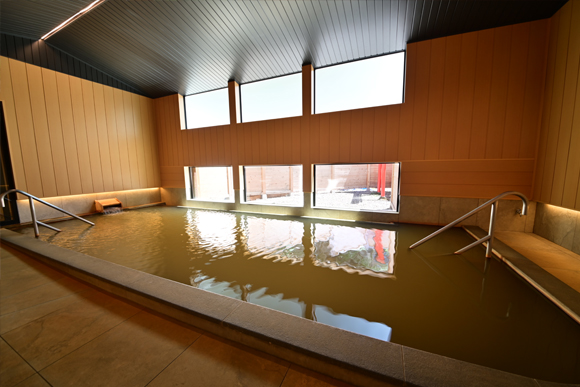 |
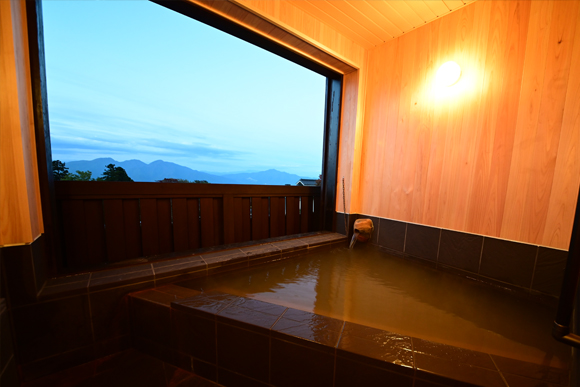 |
| The symbolic large bathhouse of this inn. The baths are filled with "Kogane-no-Yu" (golden water) which is poured luxuriously free-flowing into the bathtub. It looks like an ordinary bathtub, but it is actually 1 meter deep. Regular customers call it a hot spring pool. The size of the bathtub is 5m x 3m, and walking is fine, but if you are lucky enough to use this bath alone, there is a very high probability that you will end up swimming in it. | Guest room open-air bath in the special annex "Tsuru-no-Ie". Taking advantage of the inn's location on the slope of the Ishidan Street, the guest room open-air baths offer a view of Mt.Onokoyama and Mt.Komochiyama. Of course, the hot spring water is 100% "Kogane-no-Yu" (golden water) free-flowing hot spring water. At night, the bath can be used as an indoor bath by closing the window. To be able to freely bathe in the famous hot spring at any time of the day is the ultimate in luxury. |
| Large public baths for men and women "Takiyu" | Private bath "Kokoro" |
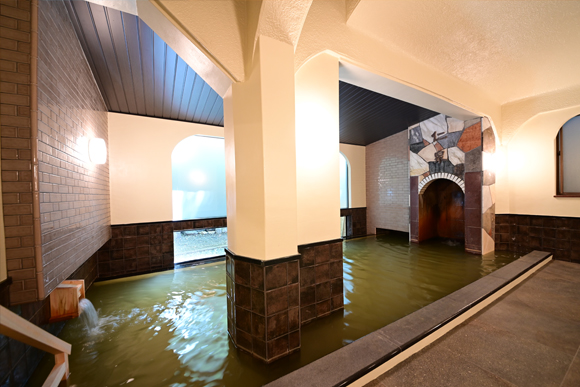 |
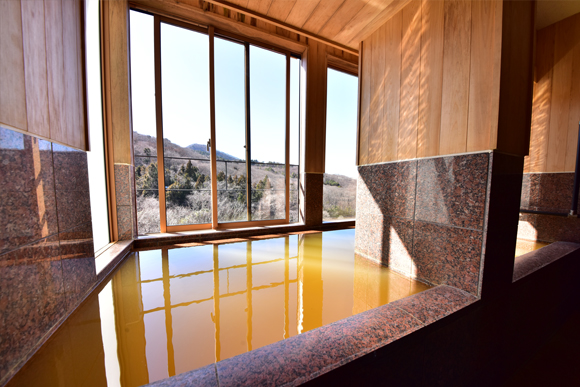 |
| The atmosphere has a retro feel that is completely different from "Ninoyu". As the name of the bath suggests, "Kogane-no-Yu" (golden water) falls into the bathtub like a waterfall. The "Takiyu" and "Ninoyu" are switched at 1:00 a.m. midnight between the men's and women's baths. If you stay overnight, be sure to soak in both baths. | Besides the public baths and open-air baths, the inn is also equipped with a private bath with free-flowing hot spring water, which can be used even late at night. The baths are free of charge. There are three other baths in addition to this one, and even when the inn is fully booked, it is possible to use them without waiting too long. |
Facility Report
Ikaho Onsen is one of the most popular hot spring areas in the Kanto region, located halfway up Mt. Haruna in Gunma Prefecture, and has a rich history and tradition from the Manyo Period (710-794). It is said that the hot spring water was discovered either 1,900 or 1,300 years ago. "Chigira Jinsentei", established over 500 years ago, is one of the oldest ryokan in the Ikaho Onsen area. The symbol of Ikaho is the 365-step Ishidan Street (stone stairway). When you climb to the top of the stone steps, near the Kawaga Bridge, you will find the source of the Ikaho Onsen "Kogane-no-Yu", and next to it, surrounded by stone walls, is the site of the "Chigira Motoyashiki". During the Tenbun era (1532-1555) of the Sengoku period, when Uesugi Norimasa, the nominal Kanto governor, was ruling the area, the Chigira clan was already in charge of the hot spring source. In the Edo period (1603-1867), the "Komaguchi Right Holders Association" was created to own the rights to the hot springs, which continues to this day, and the "Chigira Jinsentei" continued to be a central member of the association. The "Komaguchi Right Holders" (source owners) means those who own "Komaguchi", which is a hot spring piping system, and who each own a certain amount of hot spring water. Today, the 9 owners of the ryokan have formed an association to protect the centuries-old reddish brown "Kogane-no-Yu" (golden water) by stipulating strict rules for its use. Of these 9 ryokan, "Chigira Jinsentei" is said to have the largest amount of hot spring water per guest. Today, "Chigira Jinsentei" stands halfway up the stone staircase street and is also an inn connected to Tokutomi Roka (1868-1927), a great writer of the Meiji and Taisho eras. Roka loved Ikaho, especially this "Chigira Jinsentei" inn, and stayed here regularly, and even passed away here. His masterpiece, "Fujoki (The Cuckoo)" which is based on this inn was also set in this inn. Also, the poet Akiko Yosano and the great writer Junichiro Tanizaki are known to have visited the inn. Today, the inn is also known as the Imperial Family's official lodging. Despite its history and traditions, the inn is supported by a wide range of customers, with rooms available at reasonable rates, as well as rooms with the popular open-air bath. The inn has a large number of baths: large public baths for men and women + indoor baths, large public baths for men and women (Ninoyu and Takiyu), and 4 private baths that can be used free of charge. And the most wonderful thing about this inn is that the "Kogane-no-Yu" (golden water) is so abundant than other inns envy, and can be experienced as 100% natural free-flowing hot spring water. At present, there are around 50 onsen ryokan in Ikaho Onsen, but it is said that only about half of them use "Kogane-no-yu" (golden water). 9 of the right holders (source owners) must be splitting the hot spring with them. Note that "Chigira Jinsentei" does not share its hot spring water with any other ryokan. A regular customer told us that the hot springs here are "richer" than anywhere else. (Jin)
Travel Journal
Rates Data
| 1 night/2 meals fee | From 19,800 yen |
|---|---|
| 1 night/Breakfast fee | No settings |
| Stay without meals | No settings |
| Staying alone | No settings |
| Private bath fee when overnight stay |
Free |
| Day stay | No settings |
| Private bath for day-stay |
No settings |
Facility Data
| Establishment | 1502 (Muromachi period) |
|---|---|
| Check-In | 3:00 p.m. |
| Check-Out | 10:00 a.m.※"Tsuru-no-Ie", an annex of guest rooms with open-air baths, is at 11:00 a.m. |
| Location and Environment | The center of Onsen town |
| Number of Rooms | All 33 rooms (Main building: 3 rooms with half open-air bath, annex: 4 rooms with half open-air bath, 26 rooms with toilet) |
| Number of People Accommodated |
150 persons |
| Parking Area | Available for 100 cars |
| Facilities | Cafe, Bar, Esthetic salon, Table tennis, Private dining rooms, Karaoke, Shop |
| Internet | Wi-Fi available in all rooms |
| Barrier Free | Supported in some areas (wheelchair-accessible guest rooms, handrails on stairs and passageways, wheelchairs for free rental) |
| Toilet with washer | All rooms are equipped |
Transportation Access
| By train | From Ueno Station, 105 minutes by express train to Shibukawa Station, 30 minutes by bus / From Tokyo Station, take Shinkansen to Takasaki Station, 25 minutes by Joetsu Line to Shibukawa Station, 30 minutes by bus |
|---|---|
| By bus | Approx. 150 min. from Tokyo/Shinjuku Station by direct highway bus "Ikaho Onsen-go" or Kanetsu Expressway Highway Bus "Jyoshu Yumeguri-go". 7 min. walk from Ikaho Roka Kinenkan-mae stop. |
| By car | Kanetsu Expressway - Exit at Shibukawa/Ikaho IC, 20 min. |
| Address | Gunma / Ikaho Onsen / Chigira Jinsentei 45 Ikaho, Ikaho-machi, Shibukawa-shi, Gunma 377-0102, JAPAN. Phone:+81-(0)279-72-3355 |
- Data
- Aug. 19, 2024


